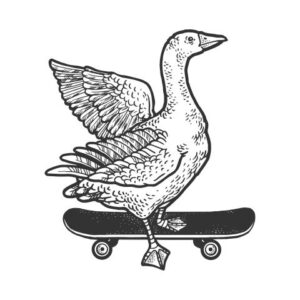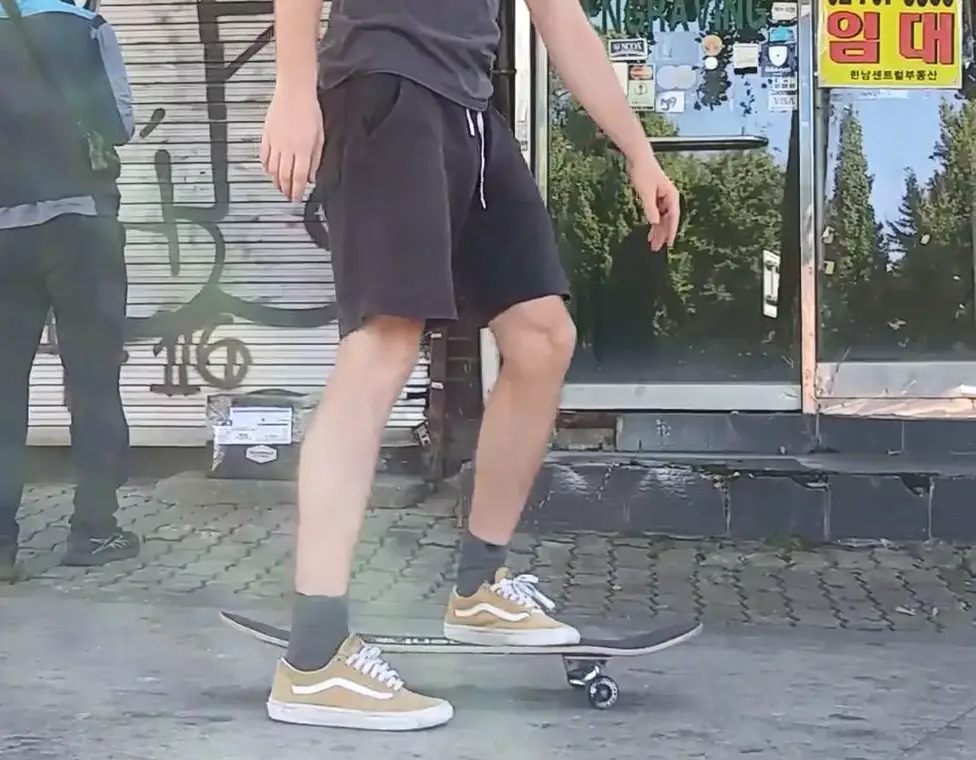Being a complete beginner in skateboarding can be hard for a couple of reasons. First, you’re self-conscious about your ability and you might be falling quite often while learning the basics.
Add on to this that you can’t do any tricks. So your skate sessions can feel a bit bland and boring. It’s true that skateboarding gets more fun when you can actually skate a bit.
So let’s go over some tricks that you can learn quickly as a beginner.
Kickturn
The Kickturn is not really considered a trick by most skaters, but it is necessary to learn if you want to get more comfortable on your board.
A Kickturn refers to lifting up the front wheels of your board and pivoting on the back wheels. When you put your front wheels back down you have “turned” the board. This technique is needed to turn on ramps or quarterpipes. It also is very useful when you need to make a sharp turn.
Practice by focusing on turning with your shoulders and trying to turn 90 degrees at first. Kickturns can be learned in a day and will lead into learning reverts and making full 180 degree turns.
Revert
The revert is really the first satisfying trick that you will learn how to do.
A revert refers to swinging your shoulders around in a rotation that causes the wheels to drag along the ground. It can be done frontside or backside and usually results in a full 180 degrees turn. The Revert creates a characteristic screeching sound as the wheels of the skateboard drag across the ground.
The Revert can be learned in just one session if you have a good concept of what the basics are. It will take some time, however, to get your Reverts consistent and controlled. I never recorded myself learning to Revert because it just happened so quickly and naturally.
Focus on turning your shoulders a full 180 degrees and then dragging the board along with you after or during the rotation. Your shoulders will always lead this motion.
Manual
A Manual is a classic trick that skaters combine with other tricks during lines to add style and finesse to their skating. There are many variations on the normal manual.
A Manual refers to lifting your front wheels up into the air and then balancing on the back wheels of your board. It is common to Ollie into a Manual on the aptly named manual pad which is just a raised flat platform. Common variations on the classic Manual include Nose Manuals, Swedish Nose Manuals, Hang Ten Manuals, and one-foot Manuals.
Finding the sweet spot to balance on takes a lot of practice, but improving your balance by practicing manuals is a great way to increase your confidence riding your skateboard. You can also start learning manuals on day one of skateboarding.
Definitely spend some time to work on your manuals.
Space Walks
Space Walks are a bit advanced to put on this list and they really aren’t so common to see. But oh are they so cool.
Space Walks are a freestyle skateboarding trick that refers to moving your skateboarding forward or backward while balancing your board on two wheels and swinging your shoulders back and forth. In some sense, a Space Walk is a special type of Manual. Similar to Manuals, there are many variations on the Space Walk.
You really need to have a good feel for Manuals before you start learning Space Walks, but it can never hurt to push yourself. Space Walks are super fun, look great, and really challenge your balance and board control.
To be completely honest, I still struggle trying to learn Space Walks, but I want people to do them more so I’m including them in this list.
Shuvit
A Shuvit is a classic and great beginner trick. A Shuvit is the beginning of more advanced spin and flip tricks.
A Shuvit refers to flicking your back foot so that the board rotates 180 degrees underneath you, but the tail of the board doesn’t touch the ground. The Shuvit it usually one of the first tricks a beginner skater will learn as you don’t need to know how to Ollie to learn this trick.
If you want to see exactly how long it takes to learn a Shuvit then check out my guide with painstakingly gathered data.
Frontside Shuvit (Front Shuv)
The Frontside Shuvit is the same as a Shuvit except the board is flicked behind you rather the board is pushed out in front of your chest. The simply changes the direction of rotation of the board. The Frontside Shuvit is another easy trick to learn, but can be a bit trickier than the normal Shuvit.
Some people claim that a Frontside Shuvit is easier to do while riding fakie, but I haven’t experienced that myself.
Dropping In
Dropping In isn’t always referred to as a trick in itself, but it sure feels like one when you’re learning how to for the first time.
Dropping In refers to when a skater starts skating a halfpipe, or bowl, by dropping into the halfpipe from the coping instead of pumping to build up speed. Dropping In is simple to learn and can be learned in a single afternoon. However, Dropping In can be very intimidating for beginner skaters.
Dropping In for the first time will probably be one of the most exhilirating feelings you’ll get while skateboarding. Start with a small mini halfpipe to make it easier to learn.
Rock to Fakie
A Rock n Roll is the first trick you will learn on a half-pipe, mini-ramp, or bowl.
A Rock to Fakie refers to riding up to the coping of the ramp, push your front truck over it, stall on the middle of your skateboard deck, and then reenter the transition. This can be intimidating because it feels like you will easily get “caught up”. This refers to having your back wheels catch the coping causing you to fall.
Definitely start by learning this on a mini-ramp until you get more comfortable
Ollie
The Ollie is thought to be a simple trick, but actually, it is really a complex set of motions. There really isn’t anything easy about it unless you’ve practiced it 1,000 different times.
An Ollie refers to flicking the tail of your board down and sliding your front foot up and forward so that the front of the board catches your front foot as it pops up. This results in the board coming off the ground and leveling out in the air.
You should start learning to Ollie as soon as you can ride your skateboard comfortably. The reason for this is that it takes so long to learn the Ollie and the Ollie is a gateway to other tricks. If you want to be doing any flip tricks then you must learn to Ollie first. However, you can and will learn other beginner tricks concurrently like the manual, shuvits, and kick turns.
Be patient with learning the Ollie.
If you want to see how like it takes to learn to Ollie check out my article that uses data to explain how and why it takes so long.
Frontside 180
Typically, you will learn to Frontside 180 immediately after learning to Ollie.
A Frontside 180 refers to turning your body and board 180 degrees while doing an Ollie. The “frontside” aspect refers to turning in the direction such that your chest faces the direction of motion. This is usually much easier to do than a Backside 180 for skaters.
It took me about 16 to 20 hours of focusing on learning the Frontside 180 to consistently land it. This constitutes roughly about 1,200-1,600 attempts of the trick. Check out my article writeup detailing this process a bit more here.
Conclusion
So that’s it.
Virtually all of these tricks will be challenging, but doable for a beginner skater to learn. Some will just take an afternoon to learn, but others such as the Ollie could take months.
Regardless, don’t get discouraged! Skateboarding is hard and is a long term process. I truly think that skating is the hardest sport out there.
Anyway thanks for reading and keep looking out for more content from Board and Wheels.


